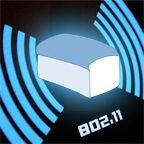Saturday 1 March, 2014, 09:03 - Satellites
 A consortium led by the Media Development Investment Fund (MDIF), and calling itself Outernet is planning to launch hundreds of small satellites (at 30x10x10 cm at their largest, they are about the size of a loaf of bread) to 'broadcast' the Internet. The idea is that selected portions of the internet will be broadcast using UDP-based WiFi multicasting (as well as, potentially, DVB and DRM).
A consortium led by the Media Development Investment Fund (MDIF), and calling itself Outernet is planning to launch hundreds of small satellites (at 30x10x10 cm at their largest, they are about the size of a loaf of bread) to 'broadcast' the Internet. The idea is that selected portions of the internet will be broadcast using UDP-based WiFi multicasting (as well as, potentially, DVB and DRM).Stepping aside from the political questions about who will decide which portions of the Internet will be broadcast - and which will not - there is the much bigger question of whether or not it is even possible to broadcast WiFi successfully from a satellite. There are several technical issues to overcome:
- The satellites, presumably in low earth orbit, will be several hundred kilometers above the planet, so the path loss will be significant.
- They will have to overcome interference from terrestrial WiFi networks on the same channel.
- The low earth orbit means they will not be stationary in the sky, leading to Doppler shift on the received signal.
 At a frequency of 2450 MHz, the free space path loss over 500 km (a typical height for low earth orbit satellites) is just over 154 dB. In reality, atmospheric absorption will increase the path-loss, as will clouds and rain, but let's assume it's a relatively clear, low humidity day. The satellite will therefore have to have a radiate a power of 154 - 90 = 64 dBm in order to achieve the necessary signal level on the ground. This is a power of just over 1.5 kiloWatts. At a satellite height of 150 km (about the minimum possible), path loss is around 10 dB less, meaning it would have to radiate a power of 150 Watts.
At a frequency of 2450 MHz, the free space path loss over 500 km (a typical height for low earth orbit satellites) is just over 154 dB. In reality, atmospheric absorption will increase the path-loss, as will clouds and rain, but let's assume it's a relatively clear, low humidity day. The satellite will therefore have to have a radiate a power of 154 - 90 = 64 dBm in order to achieve the necessary signal level on the ground. This is a power of just over 1.5 kiloWatts. At a satellite height of 150 km (about the minimum possible), path loss is around 10 dB less, meaning it would have to radiate a power of 150 Watts. If the transmit antenna has a gain of 10 dBi, which is very feasible, the transmitter power requirements end up being 150 Watts at a height of 500 km and 15 Watts at a height of 150 km. Note that no transmitter is 100% efficient, and the satellite would have to have receivers and control systems too, so the power requirements would be greater than that which the transmitter alone requires. If it is also assumed that the satellite is over the dark side of the Earth for some proportion of time, and has to rely on batteries, the solar power generation requirements increase, or alternatively the satellites would have to switch off at night.
If the transmit antenna has a gain of 10 dBi, which is very feasible, the transmitter power requirements end up being 150 Watts at a height of 500 km and 15 Watts at a height of 150 km. Note that no transmitter is 100% efficient, and the satellite would have to have receivers and control systems too, so the power requirements would be greater than that which the transmitter alone requires. If it is also assumed that the satellite is over the dark side of the Earth for some proportion of time, and has to rely on batteries, the solar power generation requirements increase, or alternatively the satellites would have to switch off at night.Of course, high gain antennas could be used on the ground, but this would then require special equipment for the satellite to be received and would go against the concept of receiving the signal on 'smartphones and tablets'.
It is not possible to easily generate 150 Watts of power on a satellite the size of a loaf of bread. A typical satellite solar panel can generate around 300 Watts per square meter of area. The total surface area of the 'loaf' would be 0.14 square meters, meaning it could potentially generate 42 Watts of power if all faces were covered in solar panels and were in full sunlight (which is, of course, impossible as at least one face would be in shadow).
Of course, the 'loaf' could have its solar panels unfold after it is launched to make a bigger panel, so the 0.5 sq metres required to generate 150 Watts might just be possible. But this would still only provide power when the satellite was in daylight. To be powered at night it would need to generate at least double the power (one lot for the transmitter and another to charge the battery) and contain a battery capable of holding the charge. This would again be difficult on a satellite of this size.
The above transmitter power calculations assume that there is no interference on the channel. If standard WiFi channels are to be used, then depending on the location it could be expected that there would be other signals around causing interference. Assuming that the main use of the satellite will be in areas where there are no other forms of Internet connection, we could take it that there would not be WiFi interference, and so arguably we could look upon the satellite kindly and disregard this effect.
On the Doppler shift issue, at 2450 MHz, the received frequency of a low earth orbit satellite will vary by around +/- 50 kHz as it passes overhead. The IEEE standard for WiFi specifies a maximum frequency error of +/- 25 parts per million (ppm) for the 2.4 GHz band. This equates to roughly +/- 60 kHz meaning that the Doppler shift of the satellite leaves it just within acceptable frequency tolerances.
So, in conclusion:

- If the 'loaf' was at 150km height it might just be able to generate enough power to transmit a WiFi signal that is strong enough to be received on the Earth. At a height of 500 km, extending solar panels would be necessary. For use at night even larger panels, plus batteries would be needed.
- Any terrestrial interference in the band would largely obliterate the satellite signal, so it would only really be receivable in remote areas (which is, after all, it's main intention).
- Doppler shift is just within acceptable tolerances.
And you can bet that if it did work, those Governments that censor Internet access would find ways to jam the signal either terrestrially or by building their own 'loaf sat', increasing WiFi interference further. The loaf-sat-wars may be just about to get toasty...
